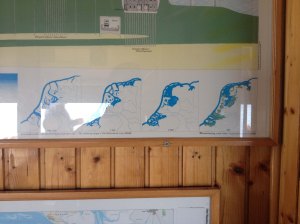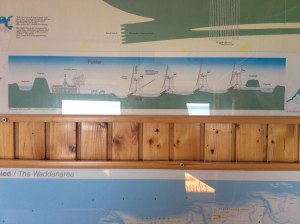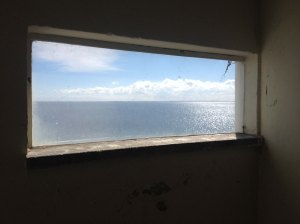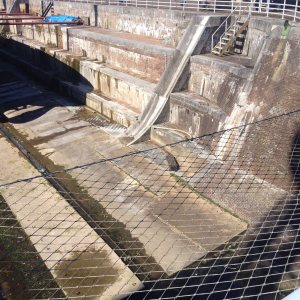What interests me here is the general rule of human ergonomics in built space that is necessary to stage various vital activities that underline our efforts to tame our natural environment. Water in this case has been the object of enquiry and scientific study for centuries in this country containing on its own right a body of knowledge and a sense of wisdom.
A reoccurring element is that one of ‘steps’, or of things being done or being represented in consequent phases or stages.
During my visit to the Monument I caught a glimpse of the graphs depicting the different stages of the embankment fill at one of Holland’s larger dijks, a massive engineering accomplishment that lasted many years until its completion.
Jaded on top the long concrete dijk that separates the sea from the artificially formed lake of Frizzland stands the observatory tower with its spiral staircase receiving hordes of tourists that can see from its bastions the difference in the water levels between the open sea and the lake formed by the dijk.
In the narrow foyer in the restaurant entrance were two graphs. One of them rendered the way old water mills carried the water from low land to higher lands through wind energy. Wind powered underwater propellers that sucked the water and transferred it through ducts into the canals ‘above’, a consequent system of mills did the same thing until a certain amount of water filled the canals on higher ground. That graph made me consider that handling water is a complex matter that demands gradual and careful handling that can only be conducted by splitting ‘work’ in various stages or steps in the effort to minimise complexity.
To handle water humans have to somehow contain it or restrict it. In the example of the water mills water can be dislocated through containing it in a network of ducts and pipes. In other cases were repairs on various parts of the dijks are necessary specialised personnel with the aid of corrugated steel walls create a contained room where pumps will remove all the water to create a water tight space. The exact same technique is also used in Venice canals.
To reach to an objective as complex as containing such an unpredictable element like water we need to resolve to an analytical sense of our environment. First thing is we need to do is try to understand what water is and how it behaves, secondly we need to ‘tame it’ with tools and elements that usually have the opposite qualities i.e matal, stone, plastics, wood.
So is there an analogy between the level of challenge that an element in a current situation of containment can pose and the number of stages or steps that are necessary to be taken to result to a viable mean of containment? Moreover, is risk higher in this case, depending on the complexity or the level of challenge? Does impending collapse and utter devastation go hand in hand with artificial environments that ingenuously contradict the forces of the natural world? Are these artificial worlds a form of human abstraction; a pixelization of the natural environment so man can walk on it in safety.
Graving docks for example (see picture below) need to be able to contain a number of activities, including that of getting the vessel off its watery element and secondly appropriating the environment to that of a safe working space to have workers accessing various of the vessels parts. Graving docks are a cross between swimming pools and industrial foundries. They are uncanny versions of our very familiar blue tiled pools only seem to be made for giants. I can only think how ships are built around the shape of fish and other marine organisms; thus, these artificial environments are indeed mimicking the spaces of natural organisms, i.e of fish and their watery cave like lairs, with the difference that ours are built so they can host human activity within them. That is evident in the way that activity and human presence is sustained by the splitting of natural forms into steps, levels and corridors. The architecture of the graving dock is a very good example of that form of abstraction defined by human scale, anatomy and function.
Moreover also evident in the methodologies we apply for containing water we need to do things in gradual steps such us flooding and pumping water out. Or things such us: pulling the boat in and out of the dock.
Again a number of human activities in certain order are necessary. Everything humans seem to activate in the context of containment seems to adapt that basic principle of steps or stages.
Humans in their effort to create safe environments, which is to to predict and control nature have created a series of complex relationships between those two systems – Natural and Artificial. Either way steps, stairs are concepts that convey a sense of resolution for humans in their strife for safety and continuous progress.




